Everyone knows the benefits of spending time outside, enjoying the outdoors. As people get older, this simple pleasure can become more challenging. They lose strength, endurance and mobility, requiring tweaks and changes to allow continued use and enjoyment in the garden.
The best approach to creating a garden for the elderly is to try to:
- Remove tripping & slipping hazards
- Use robust, low maintenance materials
- Choose low maintenance plants
- Add ramps rather than steps where possible
- Find ways to add “handrails” to provide support
- Provide sitting areas throughout the garden
- Provide multiple spots to shelter from sun, wind and rain
- Raise plants from ground level for more interaction
- Provide specialised tools for elderly users (and store them nearby)
- Have specific ‘elderly-friendly’ garden beds/spots
- Encourage wildlife to visit the garden
- Add materials & plants that prompt memories
- Ensure your garden is well lit
An additional point for people approaching older age is to ‘future-proof’ your garden. That is, include components that ‘force’ the user to do actions that will keep them strong and healthy. This is less useful for people who currently have mobility or health issues, but something to consider for those hoping to maintain those things as they get older.
Let’s have a look through the ideas we outlined above and how they can help fashion a garden for elderly users.
1. Remove Tripping & Slipping Hazards For A Senior-Safe Garden
Whether you redo the entire garden or just a small section, you want to ensure the spaces senior users will visit are flat, ‘rough’ and have no little lips or potential tripping hazards. This ties into the next point, where you want to choose ground materials that will last a long time and have little ‘movement‘. That is, they won’t warp, twist, lift or shift much over the years.
Despite how nice they look, materials like timber can warp and lift in places, catching wheels and inhibiting movement. Same with bricks or cobblestones – they can raise and shift as well over time. Not to mention the dangers of collecting water, which can freeze and become slippery.
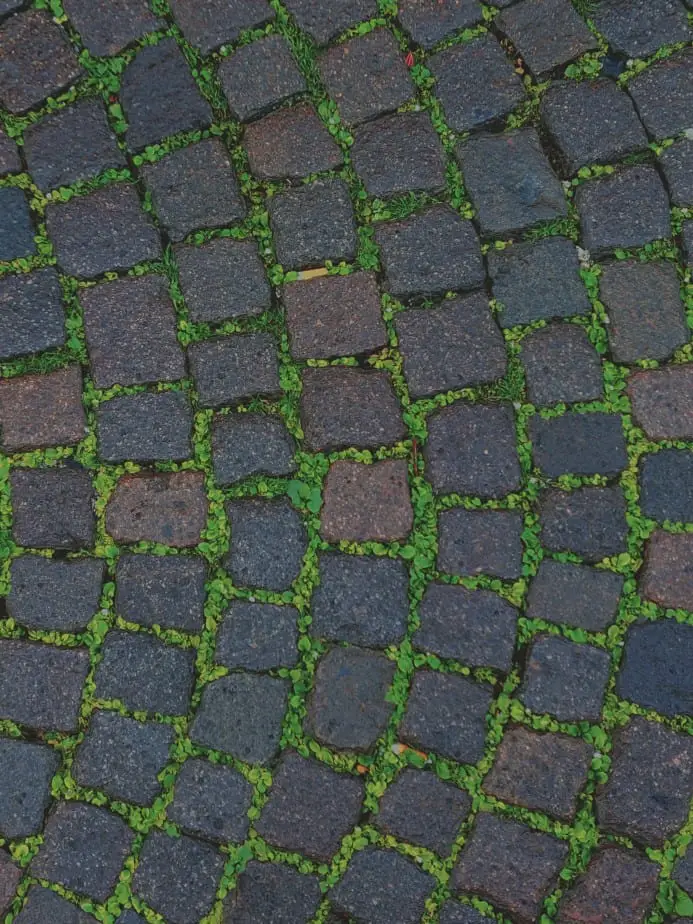
Whatever material you choose to work with, ensure it is flat, drains well and has a rough enough surface that it won’t be too slippery if wet. Drainage is very important – make sure the area slopes away from buildings and has suitable capacity to handle storms or wet weather.
2. Be Elderly-Friendly With Low Maintenance Garden Materials
As we looked at above, we want to choose materials that won’t change too much over time and throughout the seasons. Instead of going with the cheapest option, it can pay in the long run to spend a little more money up front for better, more robust materials.
Instead of timber decking, opt for composite or artificial timber. Not only will it not warp or bend, but it requires no maintenance over the years to stay in good condition. Make sure the texture of the timber has a touch of roughness to it.One tip – choose a lighter colour (especially if you live in a place with hot summers). Darker colours can be too hot to walk barefoot on. If the user is unlikely to be outside barefoot, then this is less of a concern.
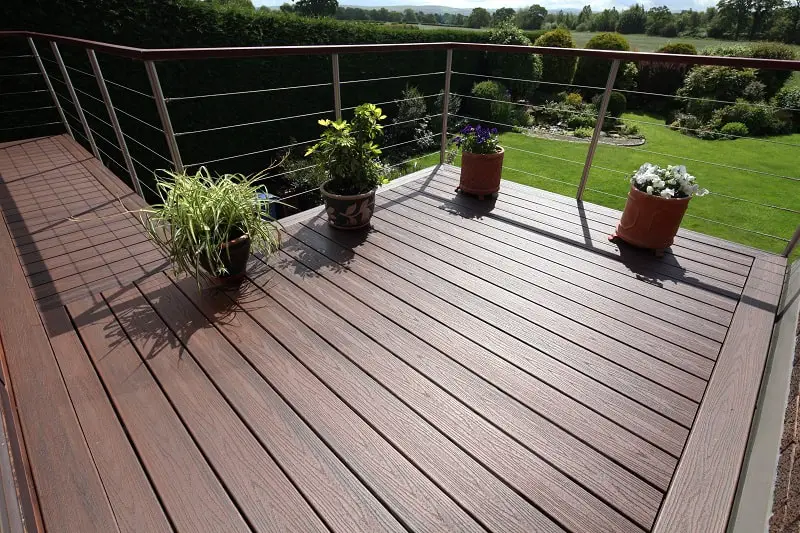
If you want to have paving, I’d again recommend spending a little more for higher quality pavers. Also choose larger sizes – the smaller they are, the more gaps there are, with more movement and potential catch points. Keep gaps around 3mm (~1/8 inch) wide to allow a little movement but prevent wheels from catching and being turned. Remember to choose something with some grip – like a sawn cut paver.

Exposed aggregate surfaces are also a good choice. They provide good grip, can suit a number of garden styles, and are smooth enough with no lips or tripping hazards. The problem is they tend to be quite expensive. But, as suggested, it may be worth the extra cost in high traffic areas.
Finally, concrete – while cheap, flat and can have a rough surface – is less appealing for a few reasons. First, it won’t necessarily last as long as a well laid paving area. Secondly, it is quite ugly to look at. It’s possible to clean it up a little, but in general it comes off looking cheap. This may not be of much concern right now, but can make it a lot less appealing to other potential buyers in the future. That said, it may be a perfect material for you – just ensure it’s well built and suits your style.
3. Reduce Work For Older Gardeners, Use Low Maintenance Plants
Like the tip above, reducing the required workload for the elderly is a great way to allow them to enjoy the garden, rather than feel like it’s a chore to maintain. Choosing low maintenance plants can go a long way to helping in this regard. And not just for the elderly users – they’re family and friends will be thankful too.
Given my audience is spread across the globe, I can’t offer specifics to your local area, however a simple Google search is a great way to get the ball rolling.
My best advice for choosing plants is to target indigenous or endemic plants – that is, plants that are native to your particular area. This is slightly more specific than plants native to your country – after all, countries like the US and Australia are large enough that a native plant won’t necessarily work in all environments.
Indigenous plants are generally much better at coping with your local conditions – rain, sun, wind and soil. If you can’t find anything you like, branch out to broader native plants. They are better at coping with similar things, just not as specialised to your location. Finally, if native’s don’t work for you, look for plants that come from similar climates to yours.

This approach often ticks one low maintenance box – requiring less watering and work to keep alive. That said, they may have other concerns such as pruning, root or plant spreading or perhaps leaf or bark litter. So while they can handle the conditions, they may still require some work to keep in order.
Your best bet is to talk to a local horticulturalist and ask for plants that are low maintenance, low usage and, perhaps most importantly, attractive!
4. Opt For Ramps Across The Backyard For Elderly Users
This is a fairly simple idea in theory that can be complex in practise. While filled with good intentions, the impact of trying to increase access with ramps often results in a giant ramp completely dominating the yard.
This solves one problem but creates another, future problem. If you’ve ever tried to sell (or buy) a house with a large access ramp, it can be a tricky thing to look past, and can impact the overall property price.
If there is a slope in the yard and you want to enable access to different areas, you need to break the ramp up into multiple sections. This serves three purposes:
- It gives you much more flexibility around where you position your different ramps – you don’t need a huge space to accommodate one giant ramp, you can slot them into different areas.
- Breaking up a long ramp gives the user – especially if they are frail – a physical and mental break. It can be very daunting looking at a large set of stairs or ramps. If they’re broken up into smaller sections, it makes it easier to manage mentally and physically.
- It looks better – multiple smaller ramps or steps are easier to blend into a design than one large set of steps or ramps
So how do you incorporate ramps into a design?
The first thing to recognise (as I point out in another point below) is that your elderly users don’t need to access every part of the yard. Focus on core areas – perhaps those near the house, a space with nice sun, another flat area for other activities, and some nice garden beds. Once you have an idea of where you want people to access, you can work to connect them up with smaller ramps between them.
You want your ramps to be no steeper than 1:15 – if you have the space. This means for every foot or metre you need to ‘fall’, you want to ‘run’ 15 feet or metres. You can potentially get away with 1:14, maybe even 1:12 in some spots, but any steeper and it becomes challenging for wheelchair users to get around without assistance.
There are a few ways to approach your ramp/s layout. One is to connect each area in a circuit – travelling along a path from one area to the next. This works well if you have either a shallow sloped garden or a very steep one.
Images below are taken from my accompanying Youtube video exploring adding ramps to your backyard. The video is linked at the end of this section.

Shallow slopes mean you can provide a gentle sloping path throughout the garden, touching on each space. Very steep gardens are likely to require terracing and/or retaining walls. Given the cost and overhaul to the garden, you probably want to have each ramp lead to a specific, chosen area without wasting space (or money).
Another layout is to have a main ‘spine‘ that you branch off to visit each area. This can work for slight or medium slopes. You just run a main sloping ramp through the garden and branch off it to other areas where needed.

When it comes to planning out your ramps, start at your house floor level (be it the back door, deck, patio etc.) and go up/down from there. Determine the height you need to cover to get where you want to, and calculate how much space you need to keep a ~1:15 gradient.
If you find the distance is quite long, it can pay to actually raise the ground level a bit – that is, add a raised area of the garden, with retaining walls to terrace it. This helps break up the overall ramp length, and can help you design new areas and spaces into the garden. A raised area can accommodate an activity area and also act as a sitting/resting area at the lower level.
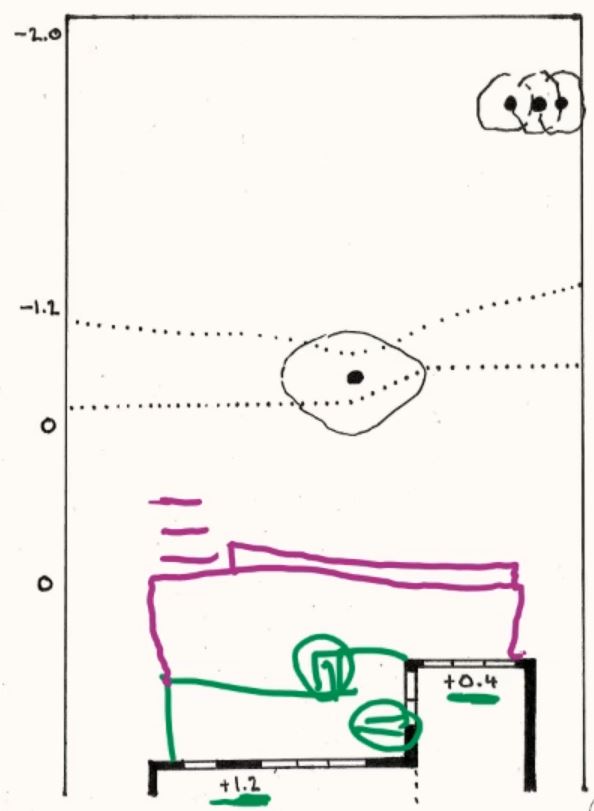
Ultimately adding ramps at multiple spots – rather than one long large ramp – will provide more flexibility and appeal to more users than just the elderly. If you’d like a little info around this idea, here is a video I developed looking at this in more detail.
5. Provide Senior Support With “Handrails” In The Garden
Just like with ramps, people often try to be helpful but end up creating an ugly headache they need to deal with later. Nothings kills the aesthetic of a garden more than an intrusive handrail weaving it’s way throughout it.
Despite the often terrible implementation, having something solid and firm elderly people can lean on is integral to helping them maintain their independence in the garden. Yes many will use strollers and the like, but often a sturdy place to lean on is better.
So, like with ramps, how can you provide useful support without ruining the aesthetic of your chosen style?
The first is to pick your spots. Consider where, on a users journey through the garden, are they likely to need a little extra help? It is likely to be getting into and out of seats, on challenging steps or slopes, and perhaps in open areas that may be slippery or treacherous.
Next, look at existing parts of your garden or design and see if you can tweak them slightly to incorporate something that could approximate a handrail or support. It might mean you replace an existing border or fence with something more solid that people can hold onto.
The supporting items can be a number of things:
- Simple uprights with laterals – like a common handrail – made from materials that suit your style
- A series of poles set close together – like a fence with missing palings – without any lateral
- Decorative garden walls at waist height
- Add a simple ledge to existing walls or fences
- Have sockets for uprights that support temporary handrails (for a few days, weeks, or years) and can be removed with little interruption
Each of these approaches allow you to provide a handrail-like support for elderly users without being an eyesore in the garden. It’s all about looking for opportunities to add little support structures into existing (or planned) elements.
Maybe take that decorative wall from two feet high up to waist height (if it won’t ruin the look of the space). Or add some uprights to different areas as ‘features’ that provide some support. Little additions that allow users to explore more of the garden than otherwise expected.
6. Provide Plenty Of Seating For Seniors Around The Garden
This is an obvious point but there is some subtlety here. Rather than purchase an off-the-shelf park bench or chair, think about how long the user is likely to sit in it. And where you want to place it. AND how exposed it will be to the elements.
If the idea is to provide a quick resting place as the user moves around the garden, then a simple flat bench or chair is probably enough. The bonus here – as we looked at in the sketches above – is you can incorporate sturdy, flat sitting surfaces in other parts of your design – like a retaining wall. You also need to think about the materials you are using and if they require treatment – like a timber chair.
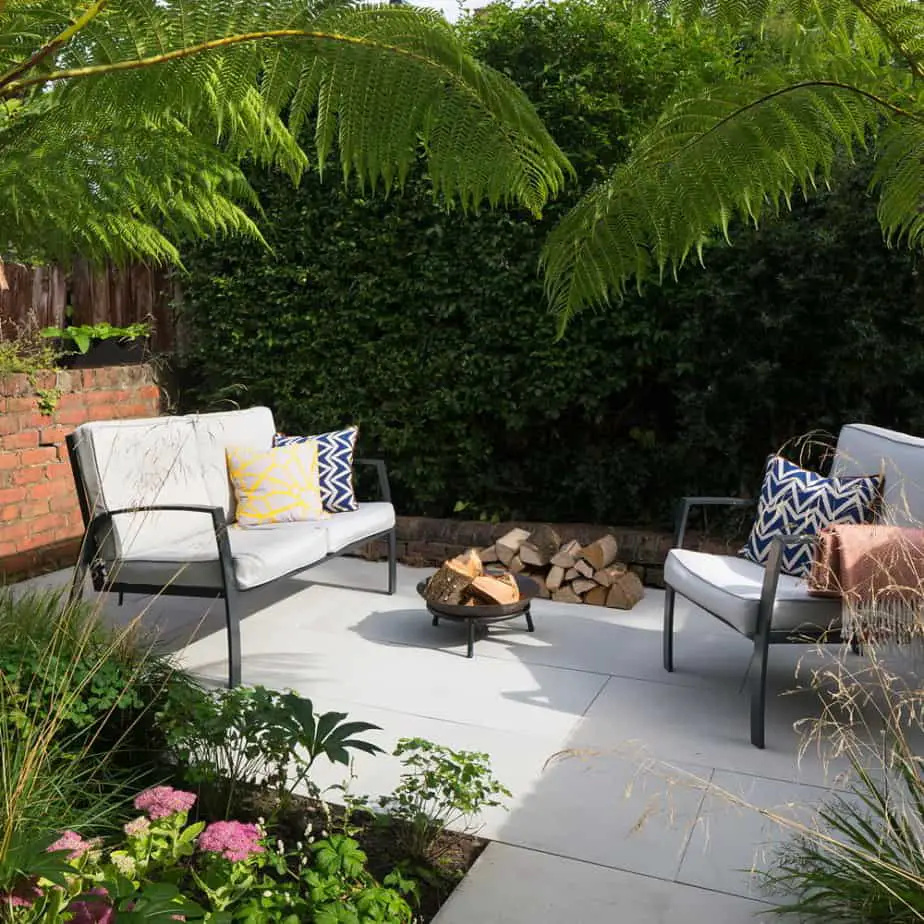
If you want the user to spend more time here, and enjoy the space or scenery, you want something more comfortable. Not only do you want a softer seat, but for elderly users you want sturdy armrests so they can get in and out of the chair easier. These needs may be met with a specific chair or two, or you can put more effort into a nicer bench multiple people can sit on.
Beyond the seating specifics, you want to place multiple spots so elderly users can rest if needed in their journey around the garden.
7. Have Multiple Spots In The Garden To Shelter Older Users
Just like having multiple sitting spots is beneficial, providing multiple spots to shelter is also important for senior users to enjoy their garden.
Shelter can be provided in a few ways, depending on what conditions you’re trying to shelter from. If the users want shelter from the sun, a tree or two is a great way to provide shade. They actively cool the space beneath them, and are the most aesthetically pleasing. Alternatives include shade sails, simple cloth covers and umbrellas.
Other options are more heavy duty, but also able to handle rougher conditions like rain or even storms (although I wouldn’t recommend the frail and elderly getting stuck outside in a storm). Pergolas or gazebos with slats or a full roof are useful features and can provide adequate shelter from the rain.
Another thing to consider is wind. Many older people feel the cold and wind more than the young, so providing places to shelter from the wind is another way to prolong their time and enjoyment outside. This requires a little bit of site analysis, to determine where the wind comes from at different times of year (and how strong it is).
Once you know how wind impacts your site, you can place walls, screens or windbreaks in specific locations to combat them and provide a protected space elderly users can sit in comfort. Have a sealed storage spot nearby for blankets and cushions and you can create a nice little sheltered pocket to enjoy the garden.
8. Increase Seniors Interaction & Enjoyment By Raising Plants Up
This is a simple and relatively cheap way to dramatically improve elderly user’s experience in the garden. Provide a seat or space to slot in their own wheelchair or stroller. Add raised beds around this spot. And make sure the plants are within arms reach, without requiring too much stretching and movement.
This approach is great if you want a particular bed of herbs, flowers or vegetables the user wants to care for hands-on. A simpler approach is to still provide raised beds, but without the leg room beneath it. Keep these beds narrow enough to reach across if the user is sitting side-on to them.
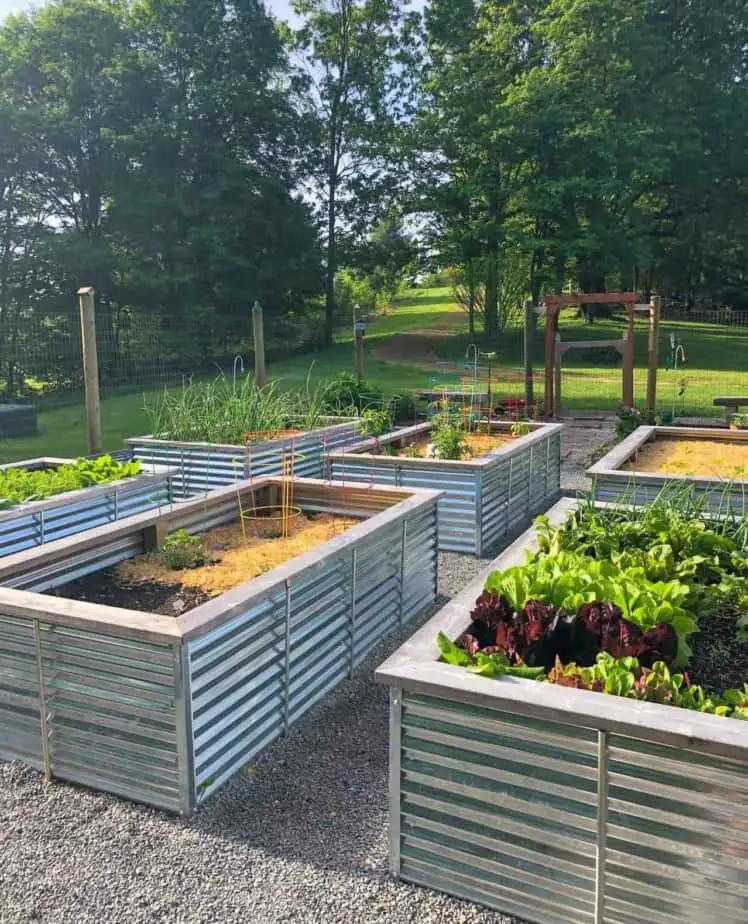
The example above – by Cassie Johnston from wholefully.com – is a great walk through of positioning and building a series of raised beds for a vegetable and herb garden. The only thing I would change for an elderly user is replacing gravel between the beds with a firmer ground material. I encourage you to look through the article and see the work she put in and what she would do differently next time.
If you can’t add raised garden beds, even pots or containers will work. And not everything has to be easy to reach. Sometimes a medium sized pot provides enough height to make interacting with plants easier.
9. Ease Plant Maintenance For The Elderly With Special Tools
If you’ve followed the tip above and provided some raised garden beds, you can go the extra mile and have some special tools to help with maintaining the garden. Tools with specialised grips or angled to make it easier to dig or prune from a seated position are available and can help prolong those with mobility or dexterity issues time in the garden.

Another thing to consider is where the tools are kept. Having a little storage compartment near the garden bed makes it that little bit easier – the only thing to consider is cleaning the tools themselves, so a tap or water bucket may be required. Alternatively, a little trolley to pull the tools along may be the best approach.
10. Choose Specific Spots For Senior Specialized Gardens
We touched on this in an earlier idea. Instead of trying to create an entire garden suitable for elderly users, focus on a few key areas that are tailored to their needs. These spaces can incorporate some of the things we looked at above – like raised activity garden beds, or sheltered sitting areas – or some new things like water features.
If you have specific spaces catering to the elderly, you have flexibility to relax your requirements elsewhere. This doesn’t mean you want to completely prevent seniors using these spaces, just that they aren’t designed to facilitate their needs.
What I like about this approach is you can make some really lovely looking areas. With careful plant and material selection (that we looked at above) you can create areas the elderly can still enjoy spending time in and around, but aren’t required to maintain or care for.
This may mean family, friends or even hired contractors are needed to help maintain the space/s. However, you may save money in the long run. It’s easier to change a few specific areas to cater to elderly users than turn the whole garden senior-safe. Perhaps the money saved can be put towards maintenance costs over the following years.
11. Encourage Wildlife In A Garden For The Elderly
This can tie into the point above. Animals and insects literally bring a garden to life. Birdsong is a joy to sit and listen to – something the elderly and their family and friends can enjoy together.
Provide little spaces throughout your design to encourage animals to explore, hunt, shelter and call. This could take the shape of artificial things like birdbaths, houses or feeders. Or something more natural – logs, rocks or plants to hide in. Flowers are always a favourite, encouraging insects and birds – and nice for people to look at.
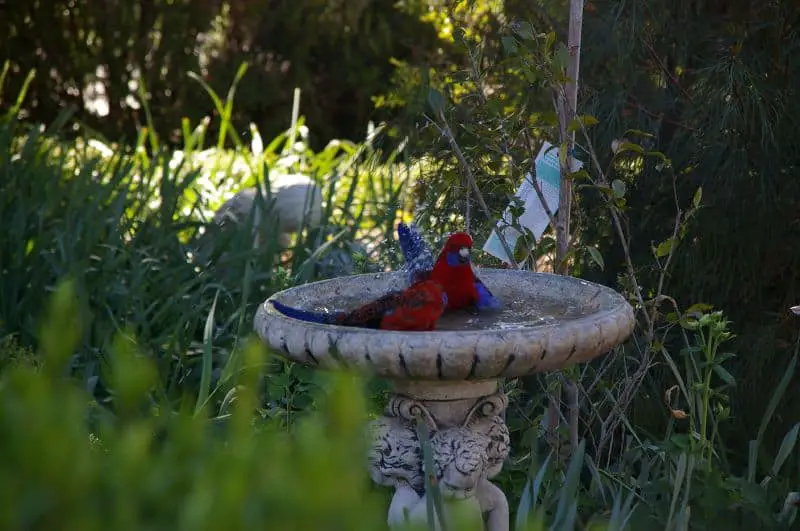
Depending on where you live, you want to be careful what you may be harbouring. In Australia, snakes, spiders and other critters can be dangerous visitors. A better option there might be the more artificial components that cater to birds or other less threatening animals. They generally have less nooks and crannies for these animals to hide in.
12. Add Garden Elements That Stir Memories For The Elderly
Along with providing refuge for local wildlife, consider adding things to the garden that bring back memories for elderly users.
Memories are an extremely powerful ‘sense’ – something many people overlook when designing. It’s also a lovely gesture to think about something an elderly parent, relative, friend or partner has mentioned in the past and include it in the garden.
It may be a material (like bricks glowing in afternoon sunlight), object (like an old tyre swing), smell (a particular flower), a sound (bird song or animal calls) or even a plant or set of plants. All these sights, sounds, smells and touches can bring back old memories.
13. Ensure Your Garden Is Well Lit & Safe For Older Users
We can think of lighting in two ways. First, to highlight features in the garden, especially in the evening and night. Second, to ensure it’s safe to move through the garden during low light.
If you have your layout of paths, ramps, areas and shelters, you want to provide adequate lighting around them. Particularly paths – make sure they are well lit so there is no danger using them.
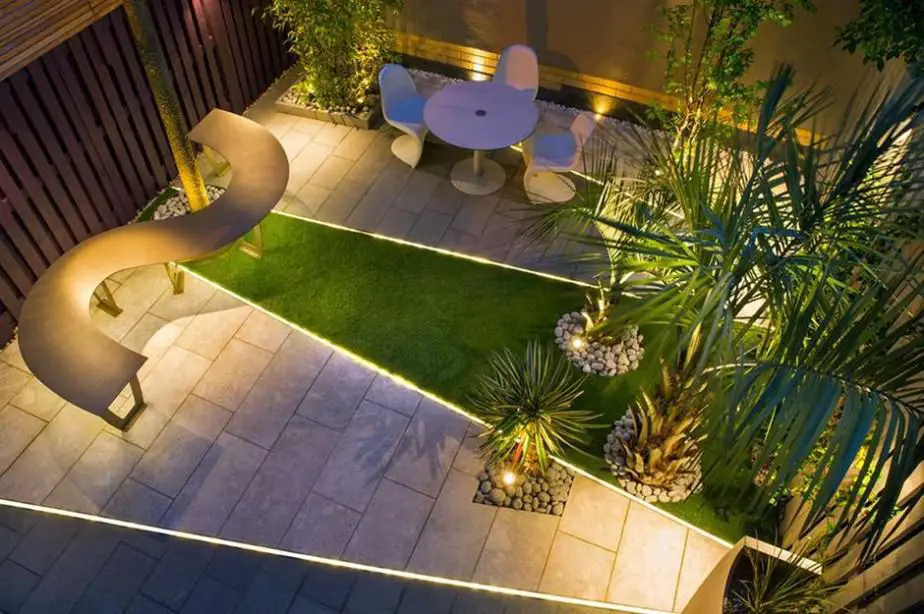
If you want to have an ‘aesthetic‘ look and a ‘safety‘ look, you may opt for an extra set of lights on a different switch. Turn on the aesthetic set as normal in the evening and night for the look. Then turn on the safety set of lights if anyone wants to go out and use the garden. They could provide more lighting to the main areas likes paths and sitting spaces.
14. “Future-Proof” Your Garden For Aging Users
What do I mean by ‘future-proofing’? It’s about looking ahead to some of the issues we’ve addressed above and altering or transforming the garden before these changes are necessary. If you or family members are still active and engaged, but could see a decline in the future, it may be worth redesigning the garden or backyard to prepare for that eventuality.
The trick with future-proofing is to look at all the ideas we’ve touched on above and… soften them slightly. Maybe you replace a set of steps with a ramp, but instead of trying to completely swap the two, you have a mix of ramps and steps. This reduces the stress of using a large flight of steps, but doesn’t entirely remove that movement from the garden.
One thing I’ve thought about is introducing ways to ‘slow‘ the aging process within the garden design. Somewhat counter intuitively, the goal is to have little spots that require physical – or mental – actions that test you a little bit.
This could take the form of still having garden beds at ground level, requiring you to still bend down a little. Yes this action may be too challenging for the infirm, but if the user is currently in good health, and they can do the action now, then continuing to do the action may prolong their strength and flexibility.
Same thing for general gardening or maintenance – while still capable, encourage the kinds of strength and endurance activities or actions that may have a positive impact on health in the long term. Maybe you design a contingency plan for the future – like being able to raise garden beds, or add ramps, or have more sitting areas – but for now, keep things a little challenging.

